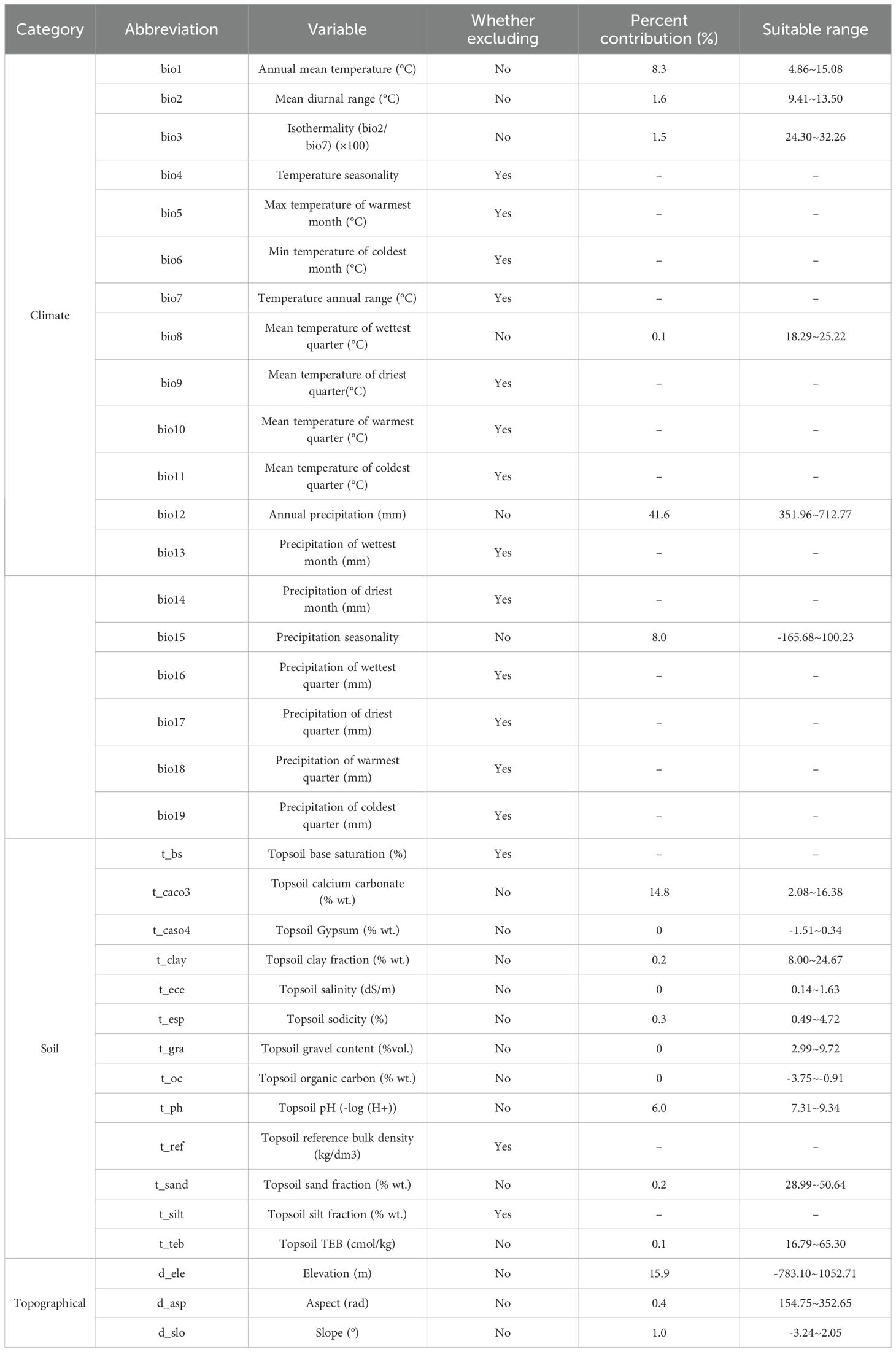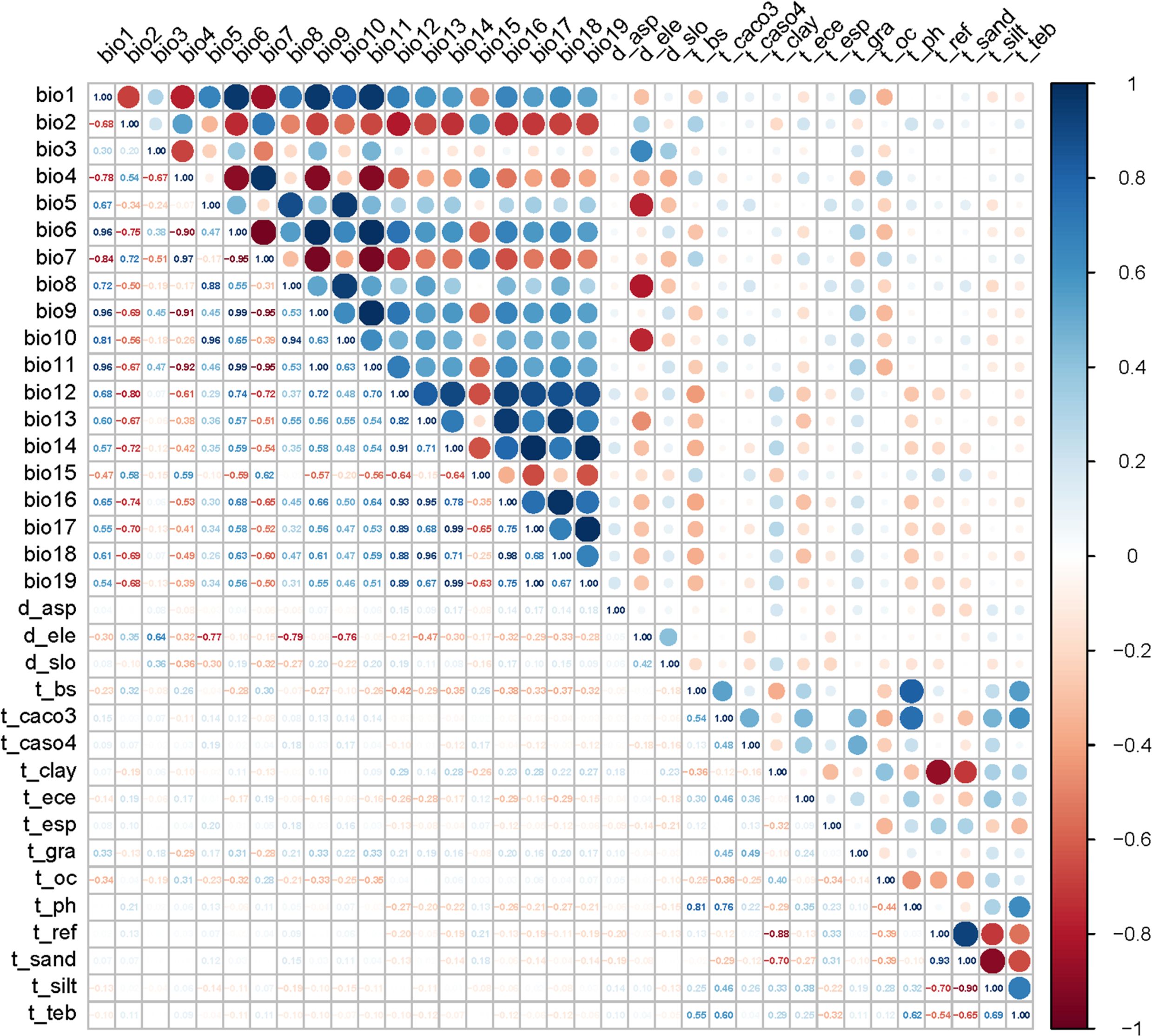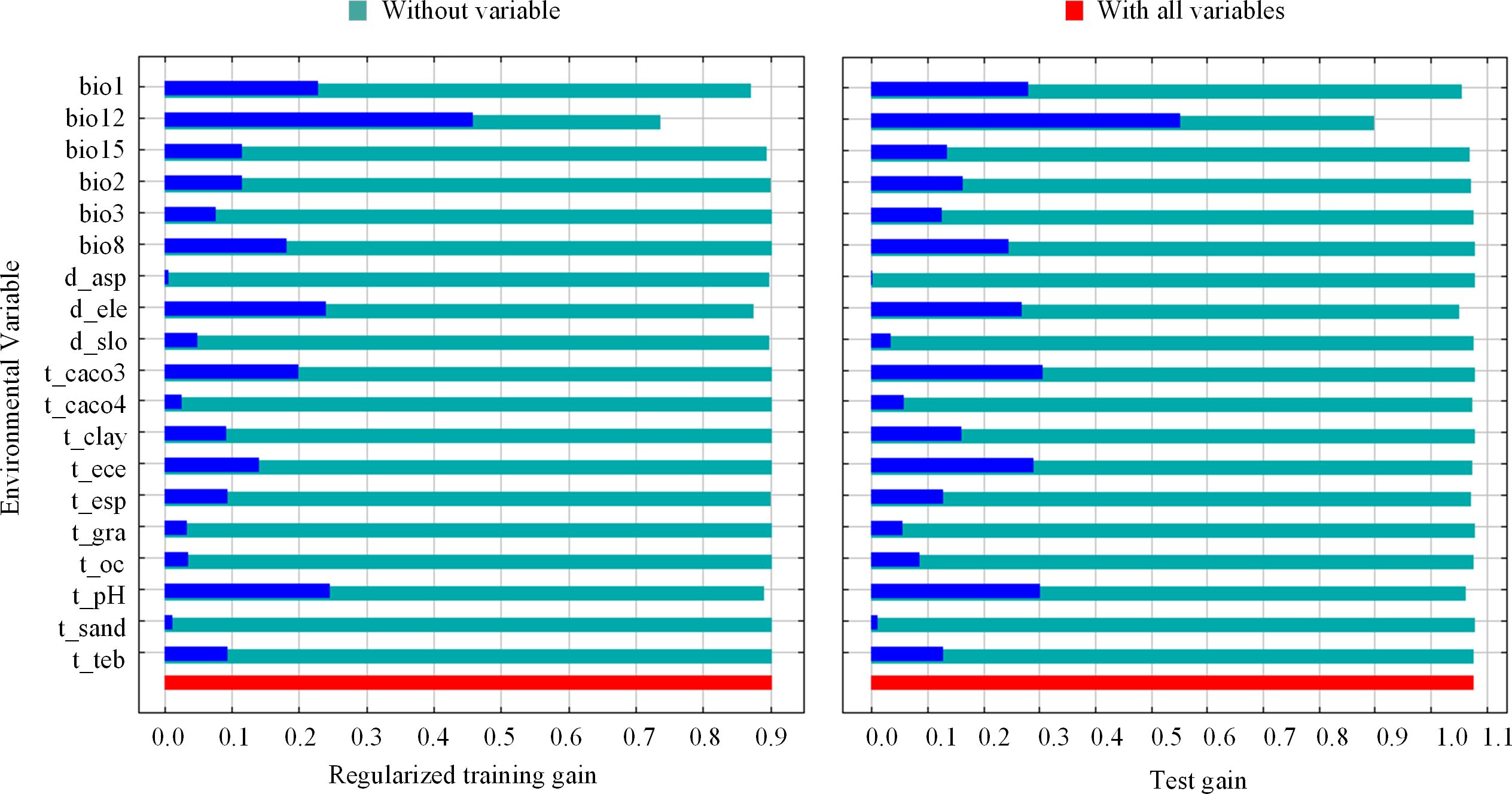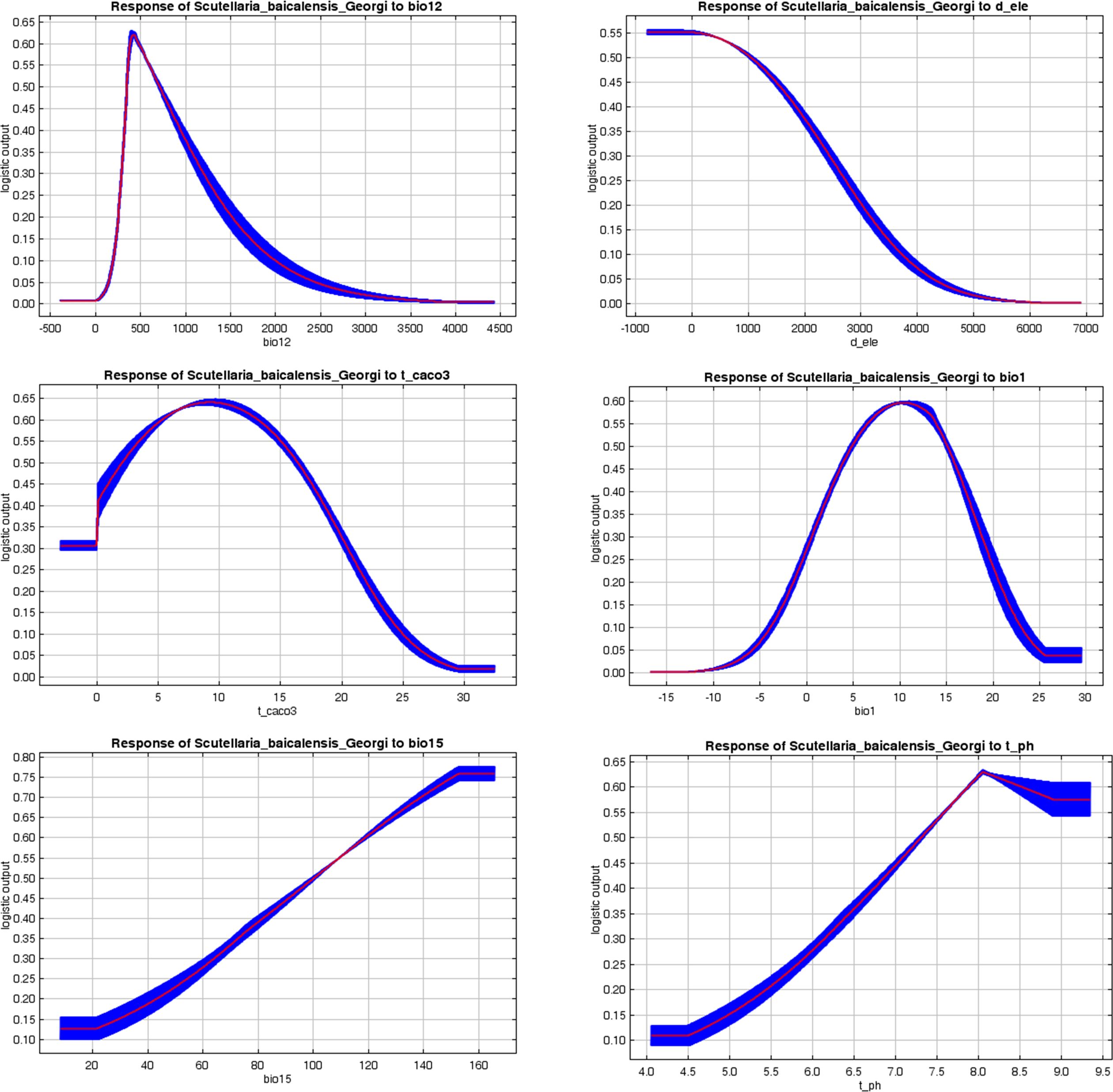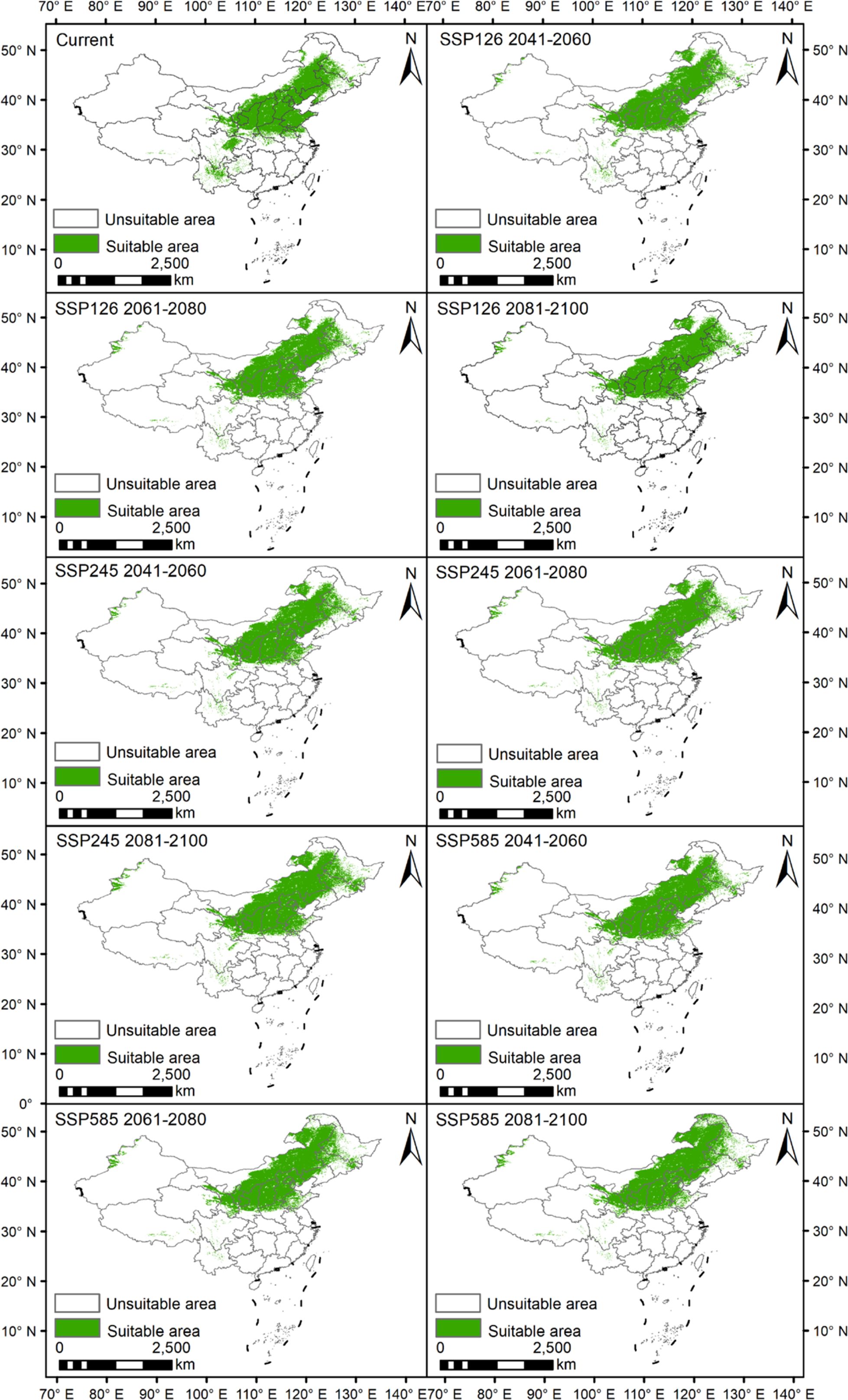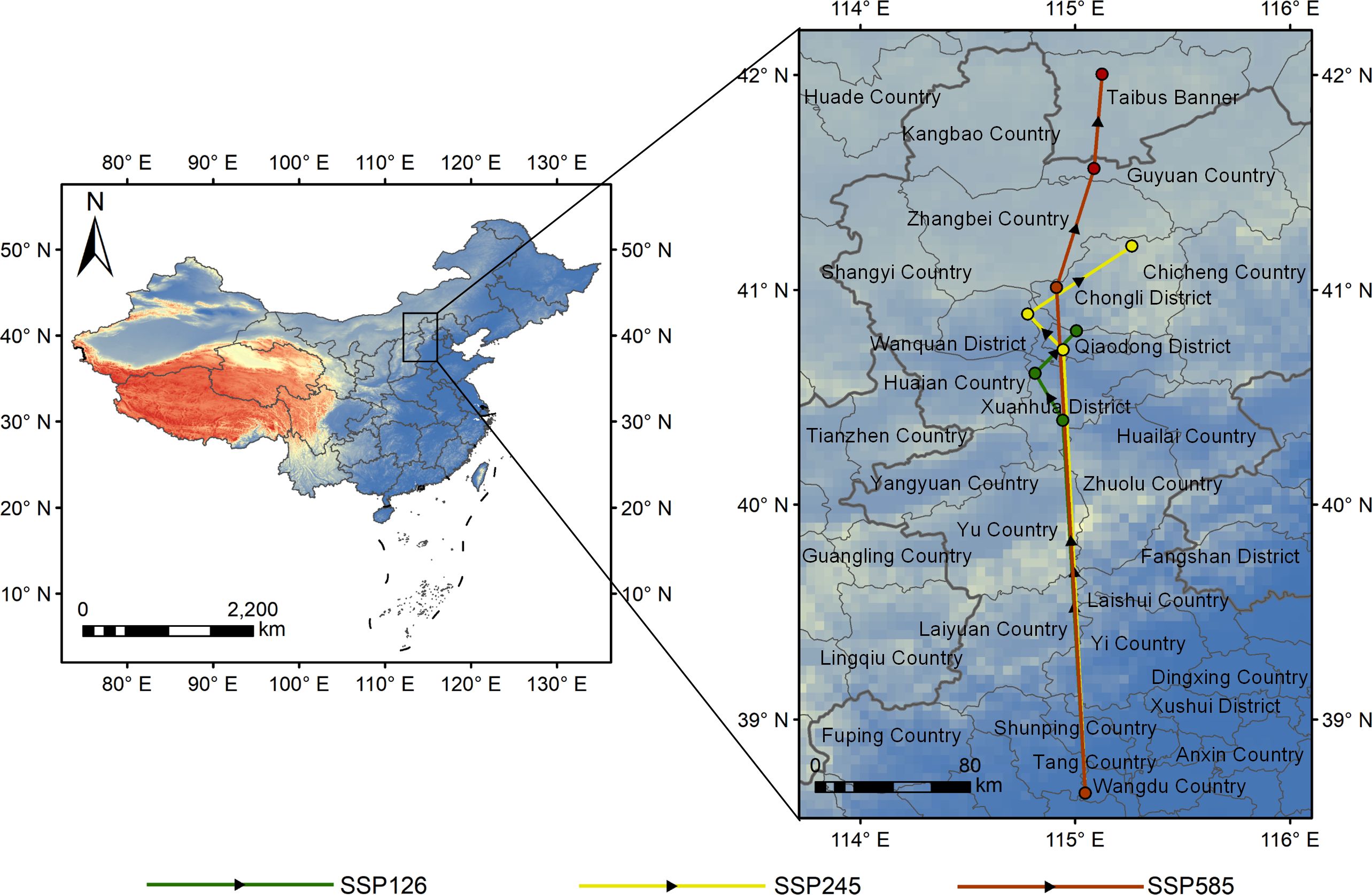- 1School of Public Health, Shandong Second Medical University, Weifang, China
- 2Department of Science and Education, Shandong Center for Disease Control and Prevention, Jinan, China
- 3AIDS Prevention and Control Section, Shandong Center for Disease Control and Prevention, Jinan, China
- 4Infectious Disease Prevention and Control Section, Shandong Center for Disease Control and Prevention, Jinan, China
Introduction: Astragali Radix is the dried root of Astragalus mongoliae or Astragalus membranaceus, a leguminous plant. Since ancient times, Astragali Radix has been widely used in Chinese traditional Chinese medicine. As people become more health-conscious, the market demand for Astragali Radix grows and its popularity is increasing in the international market. As an important medicinal plant, the growth of Astragali Radix is strongly influenced by environmental conditions. In order to meet the market demand for high quality Astragali Radix herbs, it is necessary to search and find areas suitable for the growth of Astragali Radix.
Methods: In this study, we assessed the potential impacts of climate change on the distribution of the Chinese medicinal plant Astragali Radix using the maximum entropy (MaxEnt) model in combination with a geographic information system(GIS). Distribution data and environmental variables were analyzed to predict suitable areas for Astragali Radix under the SSP126, SSP245 and SSP585 scenario for current and future (2041-2060, 2061-2080, 2081-2100). Jackknife is used to assess the importance of environmental variables, and environmental variables with a model contribution greater than 5% were considered to be the main drivers.
Results: The results showed that the current area of suitable area for Astragali Radix is 188.41 km2, and the three climate scenarios show an increasing trend in the future, with a maximum of 212.70 km2. North China has always been the main suitable area, while the area of suitable area in Southwest China is decreasing, and Xinjiang will be developed as a new suitable area in the future. Annual precipitation (41.6%), elevation (15.9%), topsoil calcium carbonate (14.8%), annual mean temperature (8.3%), precipitation seasonality (8%) and topsoil pH (6%) contributed more to the model and were the main environmental influences on the distribution of Astragali Radix. In addition, the centroids of the suitable areas shifted northward under all three climate scenarios, indicating a migratory response to global warming.
Discussion: Our study found that suitable area of Astragali Radix has been expanding for most of the time in each period of the three climate scenarios compared with the current situation. In the future, humans can focus on enhancing the cultivation techniques of Astragali Radix in these suitable areas. This study provide a scientific basis for the development of planting strategies and spatial distribution management of Astragali Radix. It helps to optimize the selection of planting areas and resource conservation of Chinese herbs.
1 Introduction
Astragali Radix is the dried root of Astragalus mongoliae or Astragalus membranaceus, a leguminous plant, which not only has good medicinal value of tonic qi, but also has the ecological functions of windbreak, sand fixation and soil and water conservation (Zhong, 2018). It is common in Eurasian countries, including China, Russia, Kazakhstan and Mongolia (Zhang, 2007). In China, Astragali Radix is mainly distributed in Heilongjiang, Jilin, Nei Mongol, Hebei, Ningxia, Gansu, Qinghai, Sichuan, and Tibet (Liu et al., 2019; Wang et al., 2023c). The polysaccharides, saponins, and flavonoids of Astragali Radix are its main active components and the main basis for evaluating the quality of Astragali Radix herbs (Zhang et al., 2022). which make Astragali Radix have a variety of medicinal values such as improving immunity, protecting the liver, nourishing and tonifying (Ma et al., 2022; Shao et al., 2023), and have been widely used in the treatment of hypoxic-ischemic encephalopathies, circulatory disorders, respiratory disorders, renal disorders, neurological disorders, and blood sugar and blood pressure. China has focused on ecological protection in recent years and advocated standardized cultivation of Chinese herbs, which has provided an opportunity for the scientific cultivation of Astragali Radix and many other Chinese medicinal plants (National Forestry and Grassland Administration, 2022).
Climatic, meteorological, topographical and geomorphological factors are of vital importance to plant cultivation, and they not only influence the growth and development of plants, but also determine their distribution range and planting strategies. The cultivation and efficacy of herbal medicines, in particular, are greatly influenced by ecological factors (Wu et al., 2019). Soil is a factor that must be considered when conducting research on plant cultivation. Previous scholars have conducted several studies on the relationship between the active ingredients of medicinal plants and soil factors (Shang et al., 2012; Hou et al., 2024; Yang et al., 2024). These studies all indicate that soil factors affect the accumulation of active ingredients in drugs. Furthermore, the geographic distribution pattern of plants will change as global temperatures rise, precipitation patterns change, and extreme weather events become more frequent (Kosanic et al., 2018). Climatic spaces suitable for plant distribution are likely to disappear (Gómez-Ruiz and Lacher, 2019), accompanied by changes in the topography suitable for medicinal plants (Li et al., 2024a). A study on the geographic distribution of plant species in China shows that 122 plant species in China are at risk of losing their geographic ranges completely under future climate change scenarios, and 125 species will migrate to higher latitudes and higher altitudes (Wang and Wu, 2024). The same migration trend was confirmed in a study by Malaysian scholars (Muzafar et al., 2022).
Ecological niche models (ENMs) are an important tool for speculating the potential distribution areas of species by comprehensively analyzing their distribution information and related environmental variables (Zhang et al., 2024b), and a variety of models have been derived, such as the Maximum Entropy Model (MaxEnt) (Zhao et al., 2022b), the biological population growth model (CLIMEX) (Early et al., 2022), the Ecological Niche Factor Analysis (ENFA) (Rosas et al., 2022), and the Genetic Algorithm Model (GAM) (Liu et al., 2012). Among them, the MaxEnt model proposed by Edwin Thompson Jaynes in 1957 is considered to be the best tool to be used in conjunction with GIS (Geographic Information System). It is a probabilistic model based on entropy maximization, which can learn conditional probability distributions by maximizing entropy under given conditions, and is able to predict the potential range of a species using known species distribution data and environmental factors (Wang et al., 2024). Due to its simplicity in modeling and accuracy in prediction, the MaxEnt model has been widely used in the fields of ecology, geography and botany in recent years. In particular, it plays an important role in the prediction of potentially suitable areas of species (Xia et al., 2023; Chen et al., 2022), the risk assessment of biological invasion (Wang et al., 2023a), and the prediction of pest and disease trends (Chen et al., 2024). Today, the MaxEnt model has been used in the distribution studies of a variety of herbal medicines, such as gastrodia elata (Hu et al., 2023), trollius wildflowers (Fan and Luo, 2024), gymnadenia conopsea (Cha et al., 2024), cinnamomum cassia (Li et al., 2024b), and so on. This provides a scientific basis for predicting the impact of climate change on the distribution of Chinese herbal medicines in suitable areas, evaluating the amount of Chinese herbal medicine resources, and guiding the selection of areas for cultivation of Chinese herbal medicines.
In recent years, wild Astragali Radix resources have been decreasing year by year, and nowadays artificial cultivation is the mainstay (Zhang et al., 2024a). Therefore, in order to conserve and cultivate Astragali Radix, it is crucial to understand its current regional distribution in China and its spatial pattern of suitable areas under future climate change. In this study, we combined the MaxEnt model and Geographic Information System (GIS) to screen the dominant environmental factors affecting the potential distribution of Astragali Radix on the basis of the available distribution information, taking into account climate, topography and soil factors (Xu et al., 2023). Meanwhile, the changes in the distribution of the possible suitable areas and the migration of centroids of Astragali Radix were predicted under the scenarios of SSP126, SSP245, and SSP585 for the years 2041-2060, 2061-2080, and 2081-2100, respectively. This study provides an important reference for future conservation and cultivation strategies of Astragali Radix.
2 Materials and methods
2.1 Data collection
Astragali Radix distribution data were obtained from the Global Biodiversity Information Facility (GBIF, http://www.gbif.org/) and the Chinese Virtual Herbarium (CVH, http://www.cvh.ac.cn/). Bioclimatic variables were downloaded from the World Climate Database (WorldClim, http://www.worldclim.Org/). Elevation data were obtained from the Geospatial Data Cloud (http://www.gscloud.cn/) of the Chinese Academy of Sciences, from which slope and aspect were extracted. Soil data were obtained from the Harmonized World Soil Database (Harmonized World Soil Database version 1.1, http://www.fao.org/soilsportal/). A total of 35 environmental variables were used in our study, including 19 climate factors, 13 soil factors, and 3 topographic factors, and all data had a spatial resolution of 2.5min (Table 1). Where bioclimatic variables included current data and future data (2041-2060, 2061-2080, 2081-2100) under the Shared Socioeconomic Pathway 1-2.6 (SSP126), the Shared Socioeconomic Pathway 2-4.5 (SSP245) and the Shared Socioeconomic Pathway 5-8.5 (SSP585). SSP126, SSP245, and SSP585 represent future climate scenarios with radiative forcing targets of 2.6, 4.5, and 8.5 W/m², respectively, and they represent different global development paths from active climate policies to high-emission trajectories.
2.2 Data processing
2.2.1 Analysis and processing of occurrence data
To avoid errors caused by clustering effects, the 802 Astragali Radix distribution data were filtered using the ENMTools 1.4 tool so that only one observation was retained in each 2.5 min grid. After removing redundant data, the final 195 distribution data were included in the model.
2.2.2 Analysis and processing of environmental variables
The 35 environmental data corresponding to the location of Astragali Radix were extracted using ArcGIS 10.7 software, and Pearson correlation analysis was performed using SPSS 25.0 software. For the environmental variables with correlation coefficients greater than 0.8 in the results, only one was retained (the one with higher contribution was selected), and finally 19 environmental variables were included in the model (Figure 1; Table 1).
2.3 Model evaluation
The ENMeval package in R 4.3.1 was used for parameter optimization to improve the accuracy of MaxEnt model by adjusting the optimal values of the regularization multiplier (RM) and the feature categories (FC) (Muscarella et al., 2014). FC (H, L, LQ, LQH, LQHP, LQHPT) and RM (0.5, 1, 1.5, 2, 2.5, 3, 3.5, 4) were combined to calculate the Akaike Information Criterion Coefficients (AICc) and to assess the model fit and complexity. The optimal combination of parameters with the minimum AICc score (DAICc=0) was eventually incorporated into the model as a way to improve the predictive performance of the model. AUC refers to the area under the ROC (receiver operating characteristic) curve which is usually utilized for testing the accuracy of a model, and it is not affected by the proportion of subjects in the analyzed sample (Parodi et al., 2022). The accuracy of the model is assessed based on the AUC value, the magnitude of which is proportional to the predictive performance of the model. The model accuracy of AUC value prediction can be categorized into four levels: excellent (0.9-1), good (0.8-0.9), fair (0.7-0.8), and poor (<0.7) (Swets, 1988).
2.4 Classification of suitable areas
The maximum test sensitivity plus specificity threshold (MTSPS) is usually used as a dividing line to delineate the suitable area of a species (Wang et al., 2024). The range is from 0 to MTSPS values for unsuitable areas and from MTSPS values to 1.0 for suitable areas. The MTSPS value of this study was 0.362, so areas with P ≤ 0.362 were classified as suitable areas for Astragali Radix, and areas with P>0.362 were classified as unsuitable areas. The predictions were imported into ArcGIS 10.7 software and the reclassification tool was used to categorize the potentially suitable areas, and the corresponding spatial areas were calculated and visualized.
2.5 Centroids of suitable areas
Mean centers of mass (centroids) for the suitable areas were calculated for each period using the Metrics Geographic Distribution tool in the Spatial Statistics tool of the ArcGIS 10.7 software. Combine centroids from different time periods into one vector data and plot migration directions and distances using the Point Set to Line tool in the Data Management tool.
3 Results
3.1 Model optimization results and accuracy evaluation
When RM was 3.5 and FC was LQH, the DAICc was 0 and the AUC value was as high as 0.889, indicating that the model had been optimized for better prediction accuracy and less overfitting. The model has higher accuracy in predicting the suitable growth area of Astragali Radix under different climatic conditions (Supplementary Figure S1; Figure 2).
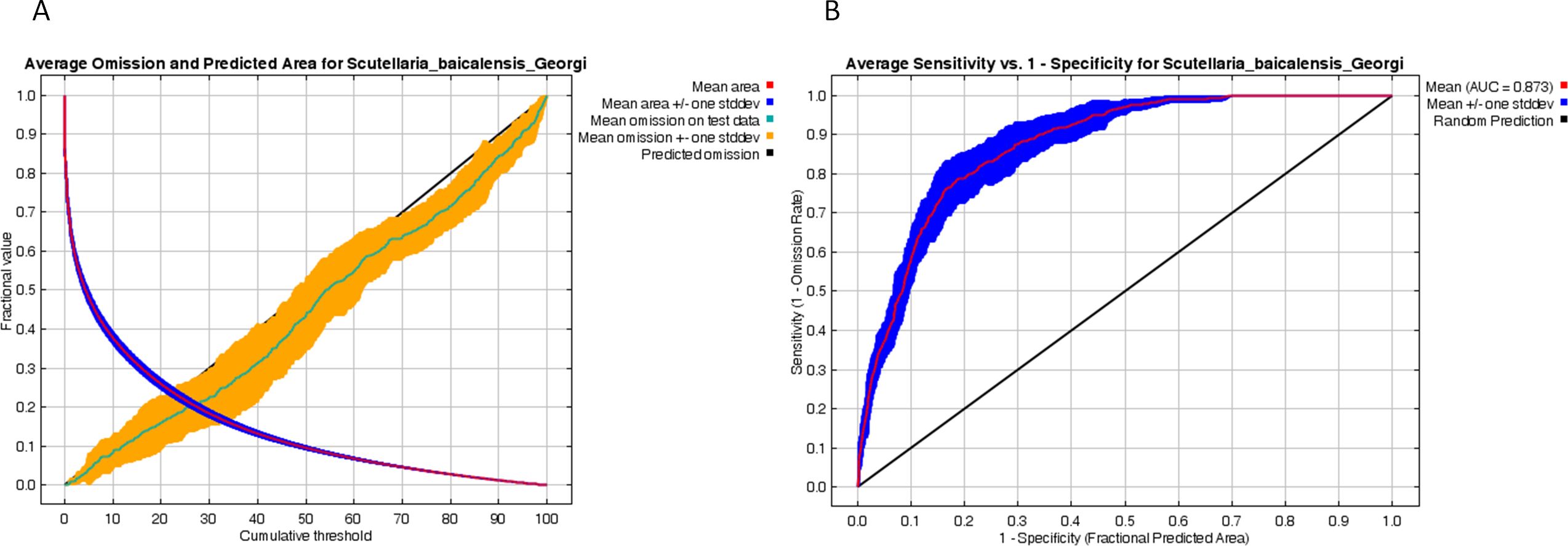
Figure 2. Model accuracy evaluation. AICc value of parameter combinations based on the ENMeval calculation. AICc, Akaike information criterion correction; L, linear; Q, quadratic; H, hinge; P, product; T, threshold. H, L, LQ, LQH, LQHP and LQHPT mean different feature categories. DAICc = 0 means the model with this parameter combination is the optimal one. ROC curves of MaxEnt result. (A) The ROC verification curve of Maxent model; (B) Jackknife test of the importance of variables.
3.2 Influence of major environmental factors
Of the 19 environmental variables that were ultimately included in the model, those with a contribution greater than or equal to 5% were bio12 (annual precipitation, 41.6%), d_ele (elevation, 15.9%), t_caco3 (topsoil calcium carbonate, 14.8%), bio1 (annual mean temperature, 8.3%), bio15 (precipitation seasonality, 8%), t_ph (topsoil pH, 6%). In addition, the jackknife test showed that bio12, d_ele, t_caco3, bio1, bio15 and t_ph all fit the training data well, indicating that they contained the most useful information not contained in the other variables (Figure 3).
The existence probability greater than and equal to 0.5 was taken as the most suitable condition for survival. From the one-factor response curve, it can be seen that when bio12 in the range of 351.96~712.77mm, d_ele in the range of -783.10~1052.71m, t_caco3 in the range of 2.08%~16.38%, bio1 was in the range of 4.86~15.08°C, bio15 in the range of -165.68~100.23, t_ph in the range of 7.31~9.34 was most suitable for growth of Astragali Radix (Figure 4).
3.3 Potential distribution of Astragali Radix in China
The results showed that under the current climatic condition, the suitable areas of Astragali Radix was 188.41×104 km2, which was mainly concentrated in North China such as Beijing, Liaoning, Hebei, Shandong, Shanxi, Shaanxi, Henan, and Southwest China, such as Yunnan, Guizhou, and Sichuan. Under the SSP126 scenario, the suitable areas increased from 187.58×104 km2 to 190.96×104 km2 and finally reached 193.70×104 km2. Under the SSP245 scenario, the suitable areas increased from 191.59×104 km2 to 195.09×104 km2 and finally reached 213.02×104 km2. Under the SSP585 scenario, the suitable areas increased from 198.46×104 km2 to 203.74×104 km2 and finally reached 212.70×104 km2 (Supplementary Table S1). The area of potential suitable areas is higher than that under the current climate conditions under all three climate scenarios. Under the same climate scenario, the area of suitable areas showed an increasing trend over time. In addition, the potential suitable areas for Astragali Radix under the three climate scenarios in the future will still be mainly distributed in North China, the suitable areas in Southwest China will be less than the current area, and new suitable areas will be developed in Northwest Xinjiang (Figure 5).
3.4 Dynamics of the future area of suitable areas
The results showed that under the SSP126 scenario, the suitable areas showed a slight contraction (-0.84×104 km2) during the period 2041-2060, followed by an expansion of 2.55×104 km2 and 5.29×104 km2 during the periods 2061-2080 and 2081-2100, respectively. Under the SSP245 scenario, the suitable areas will expand by 3.19×104 km2 during 2041-2060, 6.68×104 km2 during 2061-2080, and significantly by 24.61×104 km2 during 2081-2100. Under the SSP585 scenario, the suitable areas will expand by 10.05×104 km2 during 2041-2060, 15.33×104 km2 during 2061-2080 and 24.30×104 km2 during 2081-2100 (Supplementary Table S2). The expansion area is mainly located in Inner Mongolia Autonomous Region and northwestern Xinjiang, while the reduction area is mainly concentrated in the southwestern China. The suitable area of Astragali Radix has been expanding for most of the time in each period of the three climate scenarios compared with the current situation (Figure 6).
3.5 Centroids migration of suitable areas in the coming period
Currently, the centroid of the suitable area of Astragali Radix is located in Tang County, Hebei Province (115.047°E, 38.656°N). From now to 2041-2060, the centroids under the three scenarios of SSP126, SSP245, and SSP585 has moved by 193.02 km, 229.55 km, and 261.88 km, respectively, and the centroid is located in Xuanhua District (114.943°E, 40.391°N), Qiaodong District (114.944°E, 40.720°N), and Chongli District (114.914°E, 41.011°N). From 2041-2060 to 2061-2080, the centroid shifted by 26.71 km, 23.11 km, and 63.20 km, and the centroids were located in Xuanhua District (114.814°E, 40.611°N), Qiaodong District (114.779°E, 40.887°N), and Chongli District (115.088°E, 41.564°N), respectively. From 2061-2080 to 2081-2100, the centroid shifted by 27.25 km, 53.81 km, and 48.92 km, and the centroids were located in Qiaodong District (115.006°E, 40.808°N), Chongli District (115.265°E, 41.204°N), and Taibesiqi (115.125°E, 42.004°N), respectively. Under all three climate scenarios, the suitable areas of Astragali Radix showed a northward trend, but the degree of northward movement was different, as shown by SSP585 > SSP245 > SSP126 (Figure 7).
4 Discussion
Astragali Radix is widely cultivated in China and its distribution is highly dependent on regional environmental conditions. In view of the continuing effects of climate change, it is necessary to assess the environmental influences on the distribution of Astragali Radix and to predict suitable distribution areas for the future. This study analyzed the changes in suitable areas of Astragali Radix based on the optimized MaxEnt model for the years 2041-2060, 2061-2080 and 2081-2100. More importantly, in order to avoid the overfitting problem of MaxEnt caused by the concentrated distribution points and cross-correlation among environmental variables, this study used the spatial analysis functions of ArcGIS and ENMTools to screen the distribution points and environmental variables. In addition, the key parameters RM and FC were optimized using the ENMeval software package in order to improve the prediction accuracy of the model. The AUC value of the optimized model was close to 0.9, indicating the reliability of the model for simulation and prediction. Therefore, the model can be used to predict the distribution of Astragali Radix.
Medicinal plants are affected by a variety of environmental factors during their growth and development. Wang et al. in their study of medicinal plants on the Tibetan Plateau noted that medicinal plants are greatly affected by temperature and precipitation (Wang et al., 2021). Astragali Radix, as a typical dry perennial herb, is suitable for growth in cool and dry climatic conditions. The drought environment inhibits the growth of aboveground parts of Astragali Radix, so that nutrients are preferentially transported to the roots, which affects the accumulation of flavonoid components, thus affecting the quality of Astragali Radi (Li, 2017; Liang et al., 2016). Elevation is also a major influence on the distribution of Astragali Radi in this study. Previous studies have suggested that when Astragali Radix is planted at an altitude of about 1700 m, it is more favorable for the accumulation of its main active components (Wu et al., 2021), and thus there will be a difference in the quality of Astragali Radix planted at different altitudes. Soil moisture is another important factor that affects the distribution of Astragali Radix, and it can have an impact on the activity and reproduction of Astragali Radix pests. For example, Lerin et al. found that high moisture environments promote the hatching of weevil eggs (Lerin, 2004). Excessive soil moisture can limit the growth length of the main root of Astragali Radix, reduce the formation of lateral roots, and also highly susceptible to root skin rot (Su, 2017). In addition to climatic and topographic factors, this study also found that soil calcium carbonate also affects the suitable area of Astragali Radix. It has been previously demonstrated that calcium carbonate not only restores the original pH of the soil, but also stabilizes soil pH through its acid-base buffering capacity (Yu et al., 2017). Therefore, this favors the growth of Astragali Radi, which prefers alkaline growth conditions (Wu et al., 2015). Moreover, previous studies have found strong anthropogenic correlations with medicinal plant diversity (Zhao et al., 2022a), suggesting that anthropogenic activities may also influence the regional distribution of Astragali Radix.
Intergovernmental Panel on Climate Change (IPCC) (2023) shows that compared to 1995-2014, the likely range of projected changes in global mean annual land precipitation over the period 2081-2100 is 0.0-6.6%, and the global mean surface air temperature average is likely to increase by 0.5-1.5°C (Intergovernmental Panel on Climate Change (IPCC) (2023)). Many studies have confirmed that climate change drives species migration to higher latitudes (Wang et al., 2023b; Bertrand et al., 2011). This is consistent with the overall northward migration of centroids in the Astragali Radix suitable areas. The specific migration direction and the variability of migration distance may be related to a variety of factors, such as human activities, altitude and land use type (Ding et al., 2020; Yang et al., 2013). Moreover, while previous studies have suggested that the frequency and intensity of extreme precipitation events may increase globally (Zhou et al., 2023) and that the geographic distribution of most plants may decrease (Wang and Wu, 2024). However, the area of suitable areas for Astragali Radix will expand in the future. This may be related to the fact that the main habitat of Astragali Radix is located in the Yellow River Basin area in northern China. Because some scholars have predicted that the precipitation in the Yellow River Basin will tend to decrease after the middle of the 21st century, which will undoubtedly favor the growth of Astragali Radix, which prefers to be dry (Liu et al., 2024).
In the future, the area of suitable area for Astragali Radix in Xinjiang shows an expanding trend, and the expanding area is concentrated in the northwestern oasis belt, which may be related to the change of oasis area (Jiao et al., 2024). Under global warming, the rate of alpine ice melt will accelerate in the future, potentially leading to an increase in oasis area. Meanwhile, in high-altitude and high-latitude environments, climate change is rapidly reducing the winter snowpack and accelerating the rate of spring snowmelt (Fyfe et al., 2017; Musselman et al., 2021). Therefore, the dynamics of oases in the context of climate change need to be fully taken into account when planning Astragali Radix cultivation in order to realize the long-term benign development of the cultivation. In addition, the provinces of Yunnan, Guizhou and Sichuan are located in southwest China, which have formed a unique “microclimate zone” due to their similar geographic location and natural conditions, and have been one of the major production areas of Chinese herbal medicines since ancient times (Liu, 2018). However, this study found that the area of suitable area for Astragali Radix in Southwest China showed a decreasing trend. Previously, some scholars predicted a significant increase in temperature and precipitation in Southwest China in the future (Jin et al., 2022; Liu et al., 2022), as well as the frequent occurrence of extreme weather and events in the region due to complex topographic conditions. Together, these factors constitute a potential threat to the growth environment of Astragali Radix, and thus Astragali Radix may need to migrate to areas with higher latitudes and relatively lower temperatures and humidity to adapt to the new climatic environment. This study predicted the current and future potentially suitable areas of Astragali Radix. The results can provide some basis for the screening of ecological planting areas and the control of key ecological factors for Astragali Radix in China. Nevertheless, the suitable areas of plant species depends not only on ecological conditions, but also on other factors such as economic development, government policies, and anthropogenic disturbances, and more types of environmental data need to be collected to enhance the applicability of the model predictions in future studies.
5 Conclusion
Our study identified precipitation, elevation, temperature, topsoil calcium carbonate and topsoil pH are the key environmental variables regulating the growth of Astragali Radix. Currently, the suitable area of Astragali Radix in China is mainly concentrated in North China and Southwest China, but the area of suitable area in Southwest China will be reduced in the future, and Northwest Xinjiang may develop into a new suitable area. In addition, the centroid position of the suitable area of Astragali Radix shows a northward trend, indicating that the population of Astragali Radix may migrate to higher latitudes to cope with the environmental changes caused by global warming. This study provides a scientific basis for the development of planting strategies and spatial distribution management of Astragali Radix, and helps to optimize the selection of areas for herbal medicine cultivation and resource conservation.
Data availability statement
The original contributions presented in the study are included in the article/Supplementary Material. Further inquiries can be directed to the corresponding authors.
Author contributions
ZW: Writing – review & editing, Writing – original draft, Software, Methodology, Formal analysis, Data curation. KY: Writing – original draft, Data curation. MZ: Writing – original draft, Data curation. RM: Writing – original draft, Data curation. XZ: Writing – original draft, Funding acquisition. QD: Writing – review & editing, Methodology. XJ: Writing – review & editing, Supervision.
Funding
The author(s) declare financial support was received for the research, authorship, and/or publication of this article. This research was supported by Shandong Traditional Chinese Medicine Science and Technology Program (Q-2023008, M-2023254).
Conflict of interest
The authors declare that the research was conducted in the absence of any commercial or financial relationships that could be construed as a potential conflict of interest.
Generative AI statement
The author(s) declare that no Generative AI was used in the creation of this manuscript.
Publisher’s note
All claims expressed in this article are solely those of the authors and do not necessarily represent those of their affiliated organizations, or those of the publisher, the editors and the reviewers. Any product that may be evaluated in this article, or claim that may be made by its manufacturer, is not guaranteed or endorsed by the publisher.
Supplementary material
The Supplementary Material for this article can be found online at: https://www.frontiersin.org/articles/10.3389/fpls.2024.1505985/full#supplementary-material
References
Bertrand, R., Lenoir, J., Piedallu, C., Riofrío-Dillon, G., Ruffray, P., Vidal, C., et al. (2011). Changes in plant community composition lag behind climate warming in lowland forests. Nature 479, 517–520. doi: 10.1038/nature10548
Cha, S. N., Qi, B. R., Hu, H. X., A, L. T. S. B. E, Yong, X., Ao, U. L. J., et al. (2024). Prediction of the potential distribution area of endangered medicinal plant Gymnadenia conopsea in China under the background of climate change. Chin. J. Appl. Ecol., 1–12. doi: 10.13287/j.1001-9332.202411.023
Chen, W. J., Chen, K. L., Ma, L., Ma, W. L., Zhang, Z. H., Zhou, H. K. (2024). Predicting the risk of grassland caterpillar infestation based on MaxEnt model in Qinghai-Tibet Plateau. Grassland Turf. 44, 37–244. doi: 10.13817/j.cnki.cyycp.2024.02.025
Chen, K. Y., Wang, B., Chen, C., Zhou, G. Y. (2022). MaxEnt Modeling to Predict the Current and Future Distribution of Pomatosace filicula under Climate Change Scenarios on the Qinghai-Tibet Plateau. Plants (Basel). 11, 670. doi: 10.3390/plants11050670
Ding, W. N., Ree, R. H., Spicer, R. A., Xing, Y. W. (2020). Ancient orogenic and monsoon-driven assembly of the world's richest temperate alpine flora. Science 369, 578–581. doi: 10.1126/science.abb4484
Early, R., Rwomushana, I., Chipabika, G., Day, R. (2022). Comparing, evaluating and combining statistical species distribution models and CLIMEX to forecast the distributions of emerging crop pests. Pest Manag Sci. 78, 671–683. doi: 10.1002/ps.6677
Fan, W. H., Luo, Y. Y. (2024). Impacts of climate change on the distribution of suitable habitats and ecological niche for Trollius wildflowers in Ili River Valley, Tacheng, Altay prefecture. Plants (Basel). 13, 1752. doi: 10.3390/plants13131752
Fyfe, J. C., Derksen, C., Mudryk, L., Flato, G. M., Santer, B. D., Swart, N. C., et al. (2017). Large near-term projected snowpack loss over the western United States. Nat. Commun. 8, 4996. doi: 10.1038/ncomms14996
Gómez-Ruiz, E., Lacher, T. J. (2019). Climate change, range shifts, and the disruption of a pollinator-plant complex. Sci. Rep. 9, 14048. doi: 10.1038/s41598-019-50059-6
Hou, M. M., Gao, D., Chen, W. X., Jiang, W. J., Yu, D. D., Li, X. W. (2024). UHPLC-QTOF-MS-Based Targeted Metabolomics Provides Novel Insights into the Accumulative Mechanism of Soil Types on the Bioactive Components of Salvia miltiorrhiza. Molecules 29, 4016. doi: 10.3390/molecules29174016
Hu, J., Feng, Y., Zhong, H., Liu, W., Tian, X., Wang, Y. (2023). Impact of climate change on the geographical distribution and niche dynamics of Gastrodia elata. PeerJ 11, e15741. doi: 10.7717/peerj.15741
Intergovernmental Panel on Climate Change (IPCC) (2023). Climate Change 2021–The Physical Science Basis: Working Group I Contribution to the Sixth Assessment Report of the Intergovernmental Panel on Climate Change. (Cambridge: Cambridge University). doi: 10.1017/9781009157896 (Accessed November 28, 2024).
Jiao, Y., Yan, F., Lu, Q., Wang, Y. J. (2024). Spatiotemporal variation and driving factors of oases in the arid region of Northwest China. Chin. J. Appl. Ecology. 35, 2206–2216. doi: 10.13287/j.1001-9332.202408.025
Jin, C. X., Jiang, C., Zhang, X. Y. (2022). Evaluation and projection of temperature in southwestern China by CMIP6 models. Chin. J. Agrometeorology. 43, 597–611. doi: 10.3969/j.issn.1000-6362.2022.08.001
Kosanic, A., Anderson, K., Harrison, S., Turkington, T., Bennie, J. (2018). Changes in the geographical distribution of plant species and climatic variables on the West Cornwall peninsula (South West UK). PLoS One 13, e0191021. doi: 10.1371/journal.pone.0191021
Lerin, J. (2004). Modeling embryonic development in Sitona lineatus(Coleoptera: Curculionidae) in fluctuating temperatures. Environ. Entomology. 33, 107–112. doi: 10.1603/0046-225X-33.2.107
Li, G. Y. (2017). Correlative relationship of active constituents together with ecological factors and effects of drought stress on flavonoids in astraggalus membranaceus(fisch.) bunge. [master’s thesis] Inner Mongolia, China: Inner Mongolia University. doi: 10.7666/d.Y3271503
Li, Y. Q., Yang, Y., Gu, D. Z., Cheng, Y. R., Lv, X. J., Huang, Y., et al. (2024b). Investigation of the impact of diverse climate conditions on the cultivation suitability of Cinnamomum cassia using the MaxEnt model, HPLC and chemometric methods in China. Sci. Rep. 14, 25686. doi: 10.1038/s41598-024-75189-4
Li, M., Zhang, Y., Yang, Y. S., Wang, T. X., Wu, C., Zhang, X. J. (2024a). Prediction of historical, current, and future configuration of Tibetan medicinal herb Gymnadenia orchidis based on the optimized MaxEnt in the Qinghai-Tibet Plateau. Plants (Basel). 13, 645. doi: 10.3390/plants13050645
Liang, J. P., Jiang, X. Y., Liu, Y. L., Wu, Y., Zhou, R., Feng, Q. J. (2016). Effects of drought stress on seedling growth and accumulation of secondary metabolites in the roots of Astragalus membranaceus var. mongholicus. Acta Ecologica Sinica. 36, 4415–4422. doi: 10.5846/stxb201412162507
Liu, X. Y. (2018). Study on the eastward transportation of medicinal resources in Yunnan, Guizhou and Sichuan during the Qing Dynasty (Chongqing, China: Southwest University).
Liu, B., Chen, H. P., Hua, W. (2022). Future changes in precipitation extremes over Southwest China based on RegCM4 model simulations. Trans. Atmospheric Sci. 46, 180–192. doi: 10.13878/j.cnki.dqkxxb.20220927005
Liu, H. J., Chen, H. J., Wu, J. J., Hu, X. N., Li, Z. Y. (2012). Potential geographic distribution of Liriomyza trifolii(Burgess) prediction in China based on CLIMEX and GARP. Guangdong Agric. Sci. 39, 88–91+2. doi: 10.16768/j.issn.1004-874x.2012.07.039
Liu, Y. L., Geng, Y. P., Xie, X. D., Wang, F., Zhang., P. F. (2019). Genetic diversity and genetic structure analysis of astragalus based on SSR molecular marker. Acta Agrestia Sinica. 27, 1154–1162. doi: 10.11733/j.issn.1007-0435.2019.05.006
Liu, K., Liu, J. F., Wang, C. W. (2024). Assessment of future trends in temperature and precipitation in the yellow river basin under SSP scenarios. J. China Hydrology, 1–13. doi: 10.19797/j.cnki.1000-0852.20230321
Ma, G. H., Duan, X. M., Xu, W. H., Zhou, Y. T., Ma, H. X., Ma, W. L., et al. (2022). Identification and Laboratory Screening of Chemical Agents of Root Rot Pathogens of Astragalus membranaceus var.mongholicus. Acta Agrestia Sinica. 30, 1122–1130. doi: 10.11733/j.issn.1007-0435.2022.05.012
Muscarella, R., Galante, P. J., Soley-Guardia, M., Boria, R. A., Kass, J., Uriarte, M., et al. (2014). ENMeval: an independent evaluations and estimating optimal model complexity Maxent ecological niche models. Methods Ecology&Evolution. 5, 1198–1205. doi: 10.1111/2041-210X.12261
Musselman, K. N., Addor, N., Vano, J. A., Molotch, N. P. (2021). Winter melt trends portend widespread declines in snow water resources. Nat. Clim Change 2021:10.1038/s41558-021-01014-9. doi: 10.1038/s41558-021-01014-9
Muzafar, S. H., Badariah, H. D., Siow-Hooi, T., Hasan, Z. (2022). Impact of climate change on biodiversity loss: global evidence. Environ. Sci. pollut. Res. Int. 29, 1073–1086. doi: 10.1007/s11356-021-15702-8
National Forestry and Grassland Administration (2022). Circular of the state forestry and grassland bureau on the issuance of three general rules on ecological planting, wild nurturing, and wild cultivation of forest and grassland herbs forest reform and development [2022] no. 59. Available online at: https://www.forestry.gov.cn/c/www/gkzfwj/270489.jhtml (Accessed November 28, 2024).
Parodi, S., Verda, D., Bagnasco, F., Muselli, M. (2022). The clinical meaning ofthe area under a receiver operating characteristic curve for the evaluation of theperformance of disease markers. Epidemiol. Health 44, e2022088. doi: 10.4178/epih.e2022088
Rosas, Y. M., Peri, P. L., Lencinas, M. V., Lizarraga, L., Martínez Pastur, G. (2022). Multi-taxon biodiversity assessment of Southern Patagonia: Supporting conservation strategies at different landscapes. J. Environ. Manage. 307, 114578. doi: 10.1016/j.jenvman.2022.114578
Shang, X. N., Song, S. P., Yang, X., He, L. R., Zhao, J. B., Ding, Y. H. (2012). The research of relations between soil factors and active ingredient content of licorice in different regions in Gansu. Chin. Agric. Sci. Bulletin. 28, 245–249. doi: 10.3969/j.issn.1000-6850.2012.28.044
Shao, C. X., Lin, H. H., Jin, X. J., Li, Y. F., Liu, Y. Q., Yao, J. (2023). Historical evolution and modern research progress of Astragali Radix processing. Chin. Traditional Herbal Drugs 54, 5057–5074. doi: 10.7501/j.issn.0253-2670.2023.15.030
Su, H. Y. (2017). Cultivation technology of Chinese medicine astragalus. Feed Review. 6, 51. doi: 10.3969/j.issn.1001-0084.2017.06.018
Swets, J. A. (1988). Measuring the accuracy of diagnostic systems. Science 240, 1285–1293. doi: 10.1126/science.3287615
Wang, S. Y., Lu, Y. Y., Han, M. Y., Li, L. L., He, P., Shi, A. M., et al. (2023a). Using MaxEnt model to predict the potential distribution of three potentially invasive scarab beetles in China. Insects 14, 239. doi: 10.3390/insects14030239
Wang, E., Lu, Z., Rohani, E. R., Ou, J., Tong, X., Han, R. (2024). Current and future distribution of Forsythia suspensa in China under climate change adopting the MaxEnt model. Front. Plant Sci. 15. doi: 10.3389/fpls.2024.1394799
Wang, S. Y., Wu, J. G. (2024). Research progress on the changes in geographical distributions of plant species under future climate change scenarios in China. Guihaia, 1–58. Available at: http://kns.cnki.net/kcms/detail/45.1134.Q.20240722.1558.005.html.
Wang, W. T., Yang, T. T., Jin, L., Jiang, J. M. (2021). Vulnerability of two Rhodiola species under future climate change. Biodiversity Science. 29, 1620–1628. doi: 10.17520/biods.2021209
Wang, Z., Zhang, J. L., Jiao, H. J., Liu, J., Wang, J. Q. (2023c). Research progress on pharmacological action and quality control of effective components of Astragali Radix. Drug Eval. Res. 46, 917–924. doi: 10.7501/j.issn.1674-6376.2023.04.030
Wang, Y. J., Zhao, R. X., Zhou, X. Y., Zhang, X. L., Zhao, G. H., Zhang, F. G. (2023b). Prediction of potential distribution areas and priority protected areas of Agastache rugosa based on Maxent model and Marxan model. Front. Plant Sci. 14. doi: 10.3389/fpls.2023.1200796
Wu, L., Li, X. Z., Du, X. Z. (2015). Exploration into the requirements of Huangqi growth for natural environmental conditions. Beijing Agriculture. 2015, 84. doi: 10.3969/j.issn.1000-6966.2015.15.069
Wu, J., Li, X. W., Huang, L. F., Meng, X. X., Hu, H. Y., Luo, L., et al. (2019). A new GIS model for ecologically suitable distributions of medicinal plants. Chin. Med. 14, 4. doi: 10.1186/s13020-019-0226-0
Wu, P., Sun, Z., Yang, L. M., Hang, M. (2021). Study on effect of altitude on accumulation of main active components and expression of key enzyme genes of Astragalus mongholicus. Chin. Traditional Herbal Drugs 52, 4031–4038. doi: 10.7501/j.issn.0253-2670.2021.13.026
Xia, Y., Kazim, M., Nasir, M., Yang, Y. X., Li, Q., Li, T., et al. (2023). Suitability changes of Citrus medica L. var. sarcodactylis Swingle, a medicine-food plants affectedby climate warming using the optimized MaxEnt model. PloS One 18, e0282659. doi: 10.1371/journal.pone.0282659
Xu, H., Yue, C., Zhang, Y., Liu, D., Piao, S. L. (2023). Forestation at the right time with the right species can generate persistent carbon benefits in China. Proc. Natl. Acad. Sci. U S A. 120, e2304988120. doi: 10.1073/pnas.2304988120
Yang, X. Q., Kushwaha, S. P. S., Saran, S., Xu, J. C., Roy, P. S. (2013). Maxent modeling for predicting the potential distribution of medicinal plant, Justicia adhatoda L. in Lesser Himalayan foothills. Ecological Engineering. 51, 83–87. doi: 10.1016/j.ecoleng.2012.12.004
Yang, X. H., Li, Q., Lu, Y., Zhang, L. X., Bian, X. B. (2024). Insight into the short-term effects of TiO2 nanoparticles on the cultivation of medicinal plants: Comprehensive analysis of Panax ginseng physiological indicators, soil physicochemical properties and microbiome. Sci. Total Environ. 951, 175581. doi: 10.1016/j.scitotenv.2024.175581
Yu, Y. L., Yang, L. Z., Alfred, O. O., Xue, L. H., He, S. Y., Duan, J. J. (2017). Influence of calcium carbonate and biochar addition on soil nitrogen retention in acidified vegetable soil. Huan Jing Ke Xue. 38, 3851–3859. doi: 10.13227/j.hjkx.201702194
Zhang, L. T. (2007). The study on assessment of germplasm resources of Radix Astrsgali. [master’s thesis] (Beijing, China: Peking Union Medical College). doi: 10.3321/j.issn:1001-4454.2006.08.008
Zhang, H. P., Cui, J. J., He, X. L. (2024a). Quality Variation of Astragali Radix var.mongholicus with different Growing Years in Zizhou County. Modern Chin. Med. 26, 672–676. doi: 10.13313/j.issn.1673-4890.20240118003
Zhang, X. R., Li, X. D., Chen, Y., Zhang, C. L., Wang, J., Song, X. J., et al. (2024b). Climate niche change of Solidago canadensis during its invasion in China. Chin. J. Appl. Ecology., 1–10. doi: 10.13287/j.1001-9332.202410.001
Zhang, S. J., Zhang, Y. G., Niu, J. T., Si, X. L., L, D. H., Wu, H. W., et al. (2022). Research progress of Huangqi (Astragali radix) and prediction of its quality markers. Chin. Arch. Traditional Chin. Med. 40, 151–155. doi: 10.13193/j.issn.1673-7717.2022.02.035
Zhao, Z. Y., Xiao, N. W., Sen, M., Li, J. S. (2022b). Comparison between optimized MaxEnt and random forest modeling in predicting potential distribution: A case study with Quasipaa boulengeri in China. Sci. Total Environ. 842, 156867. doi: 10.1016/j.scitotenv.2022.156867
Zhao, R. S., Xu, T. J., Song, P. F., Zhou, X., Zhang, Y. Z., Yuan, Y. (2022a). Distribution patterns of medicinal plant diversity and their conservation priorities in the Qinghai-Tibet Plateau. Biodiversity Science. 30, 68–77. doi: 10.17520/biods.2021385
Zhong, G. S. (2018). National Higher Colleges of Traditional Chinese Medicine “3th Five –Year Plan” Textbook of Traditional Chinese Medicine. 10th Edition (Beijing: China Press of Chinese Medicine). Available at: https://image.cubg.cn/species?taxonId=sa367F39-7141-77b98-463J-685C461t507elg=&slide=0.
Keywords: Astragali Radix, maximum entropy model, geographic information system, suitable area, environmental factor, climate change
Citation: Wen Z, Yan K, Zhang M, Ma R, Zhu X, Duan Q and Jiang X (2024) Predicting the potential distribution of Astragali Radix in China under climate change adopting the MaxEnt model. Front. Plant Sci. 15:1505985. doi: 10.3389/fpls.2024.1505985
Received: 04 October 2024; Accepted: 19 November 2024;
Published: 06 December 2024.
Edited by:
Raul Antonio Sperotto, Federal University of Pelotas, BrazilReviewed by:
Ting Hua, NTNU, NorwayXinggang Tang, Jiangxi Institute of Land Space Survey and Planning, China
Copyright © 2024 Wen, Yan, Zhang, Ma, Zhu, Duan and Jiang. This is an open-access article distributed under the terms of the Creative Commons Attribution License (CC BY). The use, distribution or reproduction in other forums is permitted, provided the original author(s) and the copyright owner(s) are credited and that the original publication in this journal is cited, in accordance with accepted academic practice. No use, distribution or reproduction is permitted which does not comply with these terms.
*Correspondence: Xiaolin Jiang, anhsMTk4NjA3QDEyNi5jb20=; Qing Duan, c2RjZGNkcUAxNjMuY29t
 Zixuan Wen
Zixuan Wen Ke Yan2
Ke Yan2 Qing Duan
Qing Duan